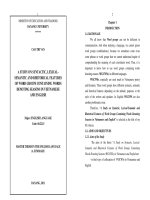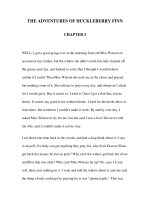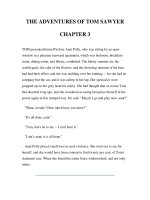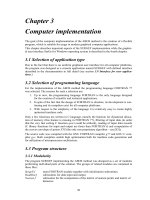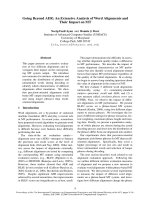Semantics chapter 3 PG-DIMENSIONS OF WORD MEANING
Bạn đang xem bản rút gọn của tài liệu. Xem và tải ngay bản đầy đủ của tài liệu tại đây (270.41 KB, 42 trang )
CHAPTER 3
DIMENSIONS OF WORD MEANING
NAMING
Ferdinand de Saussure theorizes that a “sign” has two parts: signifier and
signified. The signifier is the form that the sign will take, whether it is a sound
or image and the signified is the meaning that is conveyed.
The word is the signifier which stands for an object.
Some things are easy to name but there are imaginary and abstract things such
as: love, hate, anger, etc which are not easy to name.
NAMING
We think of names of people or places, which are proper names.
Proper names are definite.
DENOTATION
- The denotation of a word is its ‘meaning’ in the narrowest logical and
semantic sense: what a word denotes is what it refers to.
E.g. the denotation of the word winter corresponds to the season
between autumn and spring (no matter whether it is cold or snowing).
DENOTATION
Denotation is the ability of a word to identify all those things or objects
that are correctly covered by it.
Denotation of a word or expression is
independent.
invariant and utterance-
DENOTATION
A word can have multiple denotations.
For example, the dictionary lists more than 20 distinct
meanings for the word low.
"A low wall bordered the field"
"John was feeling low today."
REFERENCE
- Reference is the relationship that holds between a word or expression
and the objects it refers to (called referent).
eg: “I saw a car in the corner” a car refers to a particular member.
REFERENCE
Eg: My daughter wants to be a doctor.
(reference in my daughter, not in a doctor)
The speaker wants to indicate a particular thing in a particular
situation, not things in general.
REFERENCE
Eg:
A good student is a person who studies well.
There is no reference, or in other words, no referent.
DENOTATION vs REFERENCE
Denotation is invariant and utterance-independent.
Reference is variable and utterance-dependent.
SENSE and REFERENCE
SENSE and REFERENCE are two aspects of denotation. A word’s
reference is the set of things in the real world that it can be used to
refer to; a word’s sense is the property or characteristic it describes.
Reference
Tree (lexical item) has reference
SENSE and REFERENCE
a. Sue is looking for a dog; I hope she finds it. Its name is Fido.
b. Sue is looking for a dog; I hope she finds one. She hasn’t decided yet whether she
wants a retriever or a spaniel.
In (a), the word dog is being used for its reference; a dog in this sentence refers to
a particular actual dog. In (b), dog is being used for its sense; a dog means
‘anything that has the property of doghood’ rather than any specific dog.
SENSE and REFERENCE
- The sense of a word is its meaning in terms of the rest of the language.
- Its reference is the entity or experience in the non-linguistic world to which it
relates in a particular utterance.
Compare:
There is a tree in my garden.
I am thinking of planting a tree in my garden.
REFERENCE
- Variable reference
- Constant reference
- One referent
- No reference
- Many senses
REFERENCE
- The reference of an expression varies according to
(a) circumstances (time, place, etc.), in which the expression is used.
(b) the topic of the conversation in which the expression is used.
The present Prime Minister has variable reference (1982, 1944) >< constant
reference (the moon, The People’s Republic of China, Angola, Halley’s Comet,
etc.)
DENOTATION VS. CONNOTATION
• Denotation is the strict dictionary meaning of a word. [what it refers
to]
• Connotation is the emotional and imaginative association surrounding
a word.
• A word’s connotation is not what it refers to, but what it evokes.
(positive, neutral, negative)
Denotations
vs.
connotation
• Connotation
–
–
–
–
The belief systems of sub-groups.
connotation for a particular person in the light of particular experience.
connotation that develops within a text.
part of sense/ meaning
• Consider
• America
• Home
• Love
CONNOTATION vs. DENOTATION
- Connotation represents the various social overtones, cultural implications, or
emotional meanings associated with a sign.
- Denotation represents the explicit or referential meaning of a sign. Denotation
refers to the literal meaning of a word, the ‘dictionary definition.’
- Words have both denotations (literal meanings) and connotations (suggestive
meanings).
THE CHANGE AND DEVELOPMENT OF MEANING
THE CHANGE OF MEANING
- New meanings of the words appear.
- Some old meanings drop out of the language or co-exist with the new
ones.
He gave me a cold look.
(cold may mean distant and uncaring)
Her brother is a pig.
(pig may mean greedy or disgusting)
THE CHANGE AND DEVELOPMENT OF MEANING
Words change when either the denotation and connotation experiences
some sort of change.
Eg: silly once meant happy.
OE: husband master of the house
CAUSES OF SEMANTIC CHANGE
1. Extra linguistic causes: connected with development of society,
changes in social, political, economic, cultural life, in science and
technology.
2. Linguistic causes: factors acting within language, connected with the
system of language.
CAUSES OF SEMANTIC CHANGE
2.1. Ellipsis: If a phrase consists of two words one of them can be omitted and its
meaning is transferred to its partner:
To propose marriage = to propose
2.2. Discrimination of synonyms: the result of borrowing:
Deer: animal, beast (rats, mice and such small deer)
Now it only denotes only a certain kind of animal.
CAUSES OF SEMANTIC CHANGE
2.3. Attraction of synonyms
One of the synonyms gets new meaning, the other synonyms get this
new meaning too.
Eg:
catch means to understand and its synonyms (grasp, get) acquire this
meaning too.
CAUSES OF SEMANTIC CHANGE
3. Psychological reasons (taboos, euphemisms)
Psychological reasons concern the avoidance of expressing explicitly
problematic concepts such as death, sex…
Eg: restroom for toilet,
African-American for coloured / black
